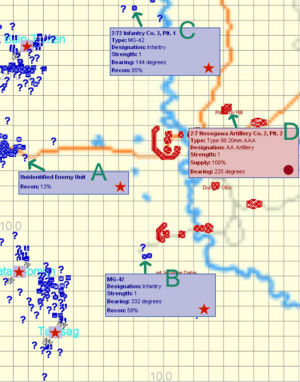Dynamic Reconnaissance
SEOW uses a very sophisticated reconaissance model to provide commanders with information on enemy force strength and disposition. Campaign admins have the option to use a "Perfect Intelligence" option which allows both sides to see ALL the enemy units ALL the time, or a "Dynamic Reconaissance" option. The first option is easy to understand, so we won't dwell on it here.
Under Dynamic Reconaissance, the campaign starts with each side having a selectable (by the admin) level of intelligence on the enemy. This simulates the pre-battle intelligence both sides usually would have. Thereafter, the amount of intelligence each commander has on his opponent decays quite rapidly over time, which introduces significant uncertainty into the commander's plans. To reduce this uncertainty, each commander has several tools at his/her disposal:
- Proximity Recon
- Recon Flights
- Pilot Reports
A skilled commander will continually use all three tools to maximize knowledge of the enemy whereabouts and strength, thus minimizing risk to friendly forces.
- Proximity Recon
All combat units in SEOW are able to detect enemy units that stray too close to them. This is an automatic feature that is calculated by SEOW at the end of each mission, taking into account the locations of all units after movement and combat losses have been applied. Different kinds of units have different recon ranges, i.e. mechanized infantry and artillery can see further than tanks, while cruisers, battleships and carriers can see further than patrol boats and destroyers. Ships have poor detection of shore-based units and much better detection of other ships.
- Recon Flights
Commanders are able to initiate recon flights. All aircraft are able to be tasked on recon flights to take photographs of specific locations. Different aircraft have different photo capacities, e.g. a B-17G can take 10 photos in a single flight, while a Bf-109F4 can only take one photo. The radius of detection of a photo depends on the recon flight altitude - the higher the recon plane is the further it can see, but with reduced clarity. Recon photos are also affected by cloud conditions and daylight. Don't send recon planes up in bad weather or night-time because they won't see anything! SEOW calculates all these corrections automatically, and also determines if moving enemy units were captured by the photo!
The big problem with recon flights is that they were highly specialized in WWII. Camera equipment was expensive, heavy and bulky. SEOW compensates for this by requiring that any fighter sent on a recon flight will fly without armament! Additionally, all recon flights will be flown by Rookie AI in a lone aircraft. These guys are doing a difficult role, so the skilled commander will escort them to ensure that the priceless information gets back to base. Photo recon from these recon flights is only accepted by SEOW if the recon plane survives the mission.
The final method of accruing information on the enemy is to encourage human pilots to submit Pilot Reports after each mission. Human pilots cannot directly increase recon levels on enemy forces in the same way that proximity recon and recon flights do. But they can place Pilot Reports on the map in the MP and add text and graphics in the reports to list what they saw in the mission, "e.g. 2 platoons of enemy tanks heading SW here". Adding a Pilot Report is a simple point-and-click operation, and it allows all friendly commanders and pilots to get a visual indication on the map itself. Pilot Reports fade out automatically as the campaign advances. So what does all this mean, graphically? As an example, below is a screengrab of the MP for a Khalkhin Gol campaign, as viewed from the Axis (red) side. The Axis commanders see all details on all friendly units, as you would expect (tooltip D). But they only see partial details on some Allied (blue) units. Only those Allied units that have recon levels greater than zero are visible. Furthermore, the amount of information available on each unit depends on its recon level. Where recon level is low, the Axis commander sees a "?" mark with sketchy details (tooltip A). Where recon is moderate some more information is available (tooltip B; strength is accurate but bearing has some uncertainty). Where recon level is high, the enemy unit affiliation details become visible (tooltip C). The location of enemy unit icons also depends on recon level. The lower the recon level, the less accurate the icon location on the map. So you see that the MP map gives an impression of the enemy forces. But the map is inaccurate (because of recon level uncertainties) and it doesn't even show all enemy units (some units might have zero recon). So the commanders' job is to build recon all the time. In the above image, the Axis commanders plainly see that there is a sizeable Allied infantry force opposing them, but numbers of tanks and artillery pieces are not clear. As time moves on, the Allied units will move constantly, and SEOW will keep track of recon levels through all the means discussed here. But without active intervention by commanders, they will likely see the situation maps reduce in recon quality. |
